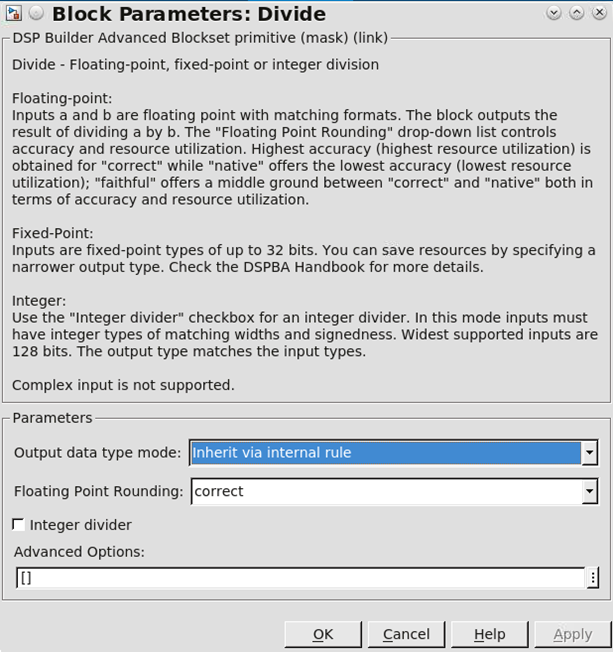DSP Builder for Intel® FPGAs (Advanced Blockset): Handbook
A newer version of this document is available. Customers should click here to go to the newest version.
14.4.25. Divide
Floating-Point Divider
DSP Builder instantiates a floating-point divider if inputs a and b are both floating-point with matching formats. You can configure the block to perform a correctly rounded, round-to-nearest tie-breaks to even division as specified by the IEEE-754 standard by selecting correct from Floating-Point Rounding under Parameters.
You can adjust the resource utilization of this block by choosing different rounding modes. Selecting faithful from Floating-Point Rounding produces a last-bit accurate result, which often consumes fewer multipliers. Selecting native further lowers the resource utilization for a slightly lower accuracy. All floating-point architectures flush subnormals to zero on both the input and the output of the block.
Fixed-Point Divider
DSP Builder instantiates a fixed-point divider if you provide fixed-point types on the inputs of the block, and you turn off Integer Divider. The maximum input bit-width in fixed-point mode is 32 bits. The output of the block is one of the two closest fixed-point values to the mathematical result of dividing a by b.
Integer Divider
DSP Builder instantiates an integer divider if the divider block has integer inputs, both signed or both unsigned inputs, matching bit-widths, and you turn on Integer Divider. The output datatype matches the input datatype. The integer division rounds to zero. For example: 6/7 = 0 and -6/7 = 0.
Divide Block Parameters

| Parameter | Description |
|---|---|
| Output data type mode | Determines how the block sets its output data type:
|
| Output data type | Specifies the output data type. For example, fixdt(1,16,15) |
| Output scaling value | Specifies the output scaling value. For example, 2^-15. |
| Floating-point rounding | This option only has an effect for floating-point inputs:
|
| Port | Fixed-Point Data Type | Integer Bits | Fraction Bits |
|---|---|---|---|
| a | sfix16_en10 | 6 | 10 |
| b | sfix12_en7 | 5 | 7 |
| q (Inherit via internal rule) | sfix29_en15 | 6 + 7 + 1 = 14 | 10 + 5 = 15 |
If you select Specify via dialog for the Output data type mode, the block restricts the allowed data types to types that trim off bits from the least significant part of the quotient (based on default type propagation): sfix29_en15, sfix28_en14, sfix27_en13, etc.
| Signal | Direction | Type | Description | Vector Data Support | Complex Data Support |
|---|---|---|---|---|---|
| a | Input | Any fixed- or floating-point type. | Numerator | Yes | No |
| b | Input | Any fixed- or floating-point type. | Denominator | Yes | No |
| q | Output | Any fixed- or floating-point type. | Result | Yes | No |